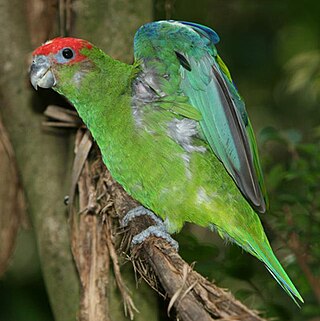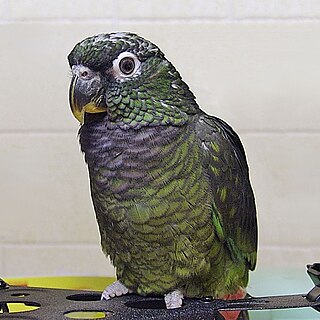
The short-tailed parrot is a species of bird in subfamily Arinae of the family Psittacidae, the African and New World parrots. It is found in Brazil, Colombia, Ecuador, French Guiana, and Peru.

The Andean parakeet is a species of bird in subfamily Arinae of the family Psittacidae, the African and New World parrots. It is found in Argentina, Bolivia, and Peru.

The blue-cheeked amazon, also known as blue-cheeked parrot or Dufresne's amazon, is a Near Threatened species of bird in subfamily Arinae of the family Psittacidae, the African and New World parrots. It is found in Brazil, the Guianas, and Venezuela.

The blue-fronted parrotlet is a species of bird in subfamily Arinae of the family Psittacidae, the African and New World parrots. It is found in Colombia, Ecuador, Panama, and Venezuela.

The vulturine parrot is a species of bird in subfamily Arinae of the family Psittacidae, the African and New World parrots. It is endemic to Brazil.

Rothschild's swift is a Near Threatened species of bird in subfamily Cypseloidinae of the swift family Apodidae. It is found in Argentina and Bolivia.

The vinaceous-breasted amazon, also called the vinaceous-breasted parrot and occasionally simply vinaceous amazon/parrot is an endangered species of bird in subfamily Arinae of the family Psittacidae, the African and New World parrots. It is found in Argentina, Brazil, and Paraguay.

The Yucatan amazon, also known as the yellow-lored amazon, Yucatan parrot or yellow-lored parrot is a species of bird in subfamily Arinae of the family Psittacidae, the African and New World parrots. It is found in Belize, Guatemala, Honduras, and Mexico.

The mitred parakeet, also known as the mitred conure in aviculture, is a species of bird in subfamily Arinae of the family Psittacidae, the African and New World parrots. It is native to Argentina, Bolivia, and Peru. It has been introduced to Uruguay and is established there. There are also substantial populations in the US states of California and Florida and smaller numbers in Hawaii.

The cobalt-winged parakeet is a species of bird in subfamily Arinae of the family Psittacidae, the African and New World parrots. It is found in Bolivia, Brazil, Colombia, Ecuador, Guyana, Peru, and Venezuela.

The orange-chinned parakeet, also known as the Tovi parakeet, is a species of bird in subfamily Arinae of the family Psittacidae, the African and New World parrots. It is found from southern Mexico through Central America into Colombia and Venezuela.

The grey-cheeked parakeet, less commonly known as fire-winged parakeet, is a vulnerable species of bird in the subfamily Arinae of the family Psittacidae, the African and New World parrots. It is found in Ecuador and Peru.

The white-bellied parrot, or white-bellied caique in aviculture, is a species of bird in the subfamily Arinae of the family Psittacidae, the African and New World parrots. It is found in Bolivia, Brazil, Colombia, and Peru.

The South American pileated parrot is a species of bird in subfamily Arinae of the family Psittacidae, the African and New World parrots. It is found in Argentina, Brazil, and Paraguay. It was formerly known as the red-capped parrot, easily leading to confusion with the Australian Purpureicephalus spurius that bears that English name.

The scaly-headed parrot is a species of bird in subfamily Arinae of the family Psittacidae, the African and New World parrots. It is also called scaly-headed pionus, Maximilian pionus, Maximilian parrot, Maximilian's pionus, or Maximilian's parrot. It is found in Brazil, Bolivia, Argentina, and Paraguay.

The blaze-winged parakeet, known as the blaze-winged conure in aviculture, is a species of bird in subfamily Arinae of the family Psittacidae, the African and New World parrots. It is found in Brazil, Bolivia, Paraguay, and possibly Argentina.

The Yungas pygmy owl, is a species of owl in the family Strigidae. It is found in Argentina, Bolivia, and Peru.

The Yungas screech owl, also known as montane forest screech-owl and Hoy's screech owl, is a species of owl in the family Strigidae. It is found in Argentina and Bolivia.

The Southern Andean Yungas is a tropical and subtropical moist broadleaf forest ecoregion in the Yungas of southwestern Bolivia and northwestern Argentina.

The Tres Marías amazon is a subspecies of bird in subfamily Arinae of the family Psittacidae, the African and New World parrots. It is endemic to the Islas Marías off the Pacific coast of Mexico.























